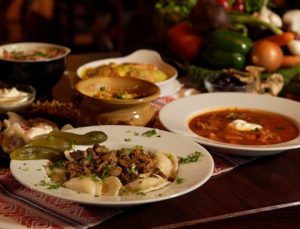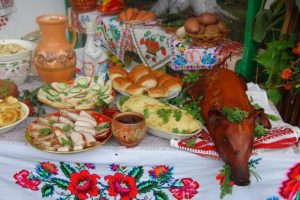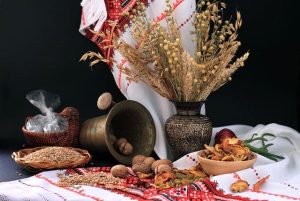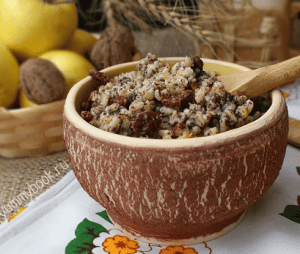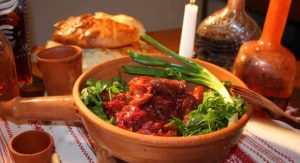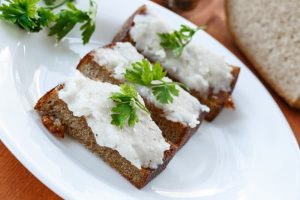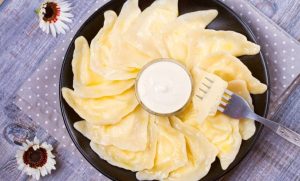According to the tradition, Ukrainians cook rich and nourishing dishes for the Old New Year’s Eve. That’s why this evening is also called “Generous Evening” (Shchedryi Vechir).
Kutia is the main ritual dish. It is cooked with dried fruits, poppy seeds, nuts, and honey, and is dressed with cream or rendered pork fat.
Apart from kutia, the festive Old New Year table in Ukraine is loaded with a bunch of tasty meals. It is believed the more dishes you have on the table – the more prosperous year will be.
The traditional Old New Year table was rich in dough meals:
- varenyky (dumplings) with different fillings (meat, cheese, poppy seeds, etc.)
- pancakes (a symbol of the sun and well-being)
- knyshi, kalachi, and palianytsi (symbols of welfare – Ukrainians believe the better and the more golden brown bakery is, the more happiness you’ll have in the New Year).
Girls also baked ceremonial buns called balabushky which they used for fortunetelling: balabushky were laid out on the bench and then a hungry dog was “invited”: whose bun the dog will eat first, that girl is going to get married first.
According to folk customs, Ukrainians also cooked pork bellies, boiled kholodets (meat jelly) using pork legs, made blood and liver sausages, prepared vereshchaka (ancient Ukrainian dish made of pork ribs), fried and smoked salo (pork fat), made small open sandwiches with salo called potaptsi, boiled borsch, and more.
Ukrainians also served dishes made of pork, a symbol of cattle fertility and land capacity. It is believed that such a treat will contribute to the family’s well-being in the coming year.
In some regions, it wasn’t frowned upon to cook poultry and fish dishes for the New Year’s Eve. Such treats were thought to bring poverty since all wealth and fortune would “float away” or “fly away” from home.
Ukrainians covered the festive table with towels and decorated it with spikelets. They put kutia in the center of the table and lit a candle to honor the memory of their ancestors.
The main rule was not to put old, dirty, or cracked kitchenware on the table. You also had to dress in clean clothes, symbolizing the renewal and beginning of a new life.
Now we’re going to share 5 delicious recipes for the Old New Year.
Generous kutia
In ancient times, generous kutia was cooked in a special way.
The oldest woman in the family was supposed to bring grains at 2 o’clock in the morning and the oldest man of the family had to bring water from a river or well.
The grains and water were left on the table and were strictly forbidden to be touched until the fire was set in the hearth since in other way kutia will not taste good.
Ingredients:
- 400 g (14 oz) wheat grains
- 200 g (7 oz) poppy seeds
- 100 g (3,5 oz) walnuts/hazelnuts
- 100 g (3,5 oz) dried fruits
- 100 ml honey
- 2-3 tbsp dairy butter
Cooking
Pour water above wheat grains and let them soak for 1-2 hours. Boil the grains until done. (grain and water proportion 1: 2.5).
Pour boiling water above poppy seeds and let them stand for 15 minutes. Chop nuts and cut dried fruits finely. Mix all the ingredients together and add them to the wheat.
Dissolve honey in a glass of warm water or uzvar and pour it above the boiled grains. Kutia should not be watery, so you may not need all the honey mixture.
At the very end, add warmed dairy butter to kutia. Stir all ingredients well before serving.
Vereshchaka (pork ribs)
Ingredients:
- 400 g (14 oz) pork ribs
- 200 g (7 oz) white bread loaf
- 60 g (2 oz) salo
- 2 medium bulb onions
- salt, ground black pepper and other spices to taste
- fresh herbs for serving
- beet kvas (fermented beet drink)
Cooking
Rub pork ribs with salt and pepper. You can optionally add any other spices you like. Fry them in a deep frying pan until crusty. Add 500 ml of beet kvass to the pan and put it in the oven for 30 minutes.
Cube the bread loaf finely and add it to the frying pan – leave everything in the oven for another five minutes. Finally, add chopped and fried bulb onions and salo. Remove the dish from the oven and top with fresh herbs. Serve vereshchaka in deep bowls.
Salo appetizer
Ingredients:
- 200 g (7 oz) salo
- 5-7 slices of brown bread
- salt, ground black pepper to taste
- fresh herbs for serving
- several garlic cloves of garlic
Cooking
Take fresh, chilled, even a little bit frozen salo and mince it through the grinder. Season it with salt and pepper. Stir in squeezed garlic cloves and mix everything well.
Leave the mass for a few hours to let spices and garlic give off their flavor. Spread the mass on black bread and top it with fresh herbs serving. This appetizer will taste great with borscht or other meat dishes.
Varenyky with farmer’s cheese
Ingredients:
- 400 g (14 oz) flour
- 45 g (1,5 oz) sugar
- 20 ml dairy butter
- 2 eggs
- 1 tsp salt
- 150 ml milk
- 600 g farmer’s cheese (15-18% )
Cooking
Sift 200 g (7 oz) of flour. Add salt and dairy butter. Pour in warm milk and 150 ml of boiling water. Stir everything to combine. Add the remaining sifted flour to the mass and knead the dough well. Leave for half an hour.
Combine farmer’s cheese, egg, and sugar. Mix the mass until smooth.
Roll out the dough (1 mm thickness) and cut circles (8-9 cm in diameter). Put the filling in the middle of each circle and gently pinch the edges so that the stuffing does not come out during cooking. Repeat until you use all ingredients.
Put the dumplings into boiling, slightly salted water and cook until they come to surface. Serve with dairy butter, sour cream or jam.
Uzvar with raisins and cherries

Ingredients
- 100 g (3,5 oz) dried apples
- 100 g (3,5 oz) dried pears
- 100 g (3,5 oz) prunes
- 100 g (3,5 oz) dried apricots
- 100 g (3,5 oz) raisins
- 100 g (3,5 oz) dried cherries
- 100 g (3,5 oz) sugar
Cooking
Wash dried fruits under running water thoroughly.
Pour 2-3 liters of water in the pan and bring it to a boil. Add in all dried fruits. Bring the water to boil and reduce heat to medium. Cook everything 15-20 minutes under the lid.
In 5 minutes until ready stir in the sugar. After removing from heat, infuse uzvar for about 12 hours. Before serving, strain the drink (it’s optional).
Have you liked the article about dishes on the Ukrainian Old New Year Table?
Join and follow us on social media to keep up-to-date with our freshest recipes, cooking tips, and entertaining articles related to the Ukrainian people, culture, and traditions!
Find us on Facebook, Instagram, Pinterest, etc. to comment and share your favorite Ukrainian recipes with friends and relatives!



